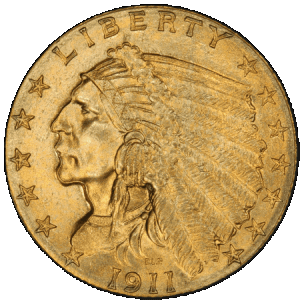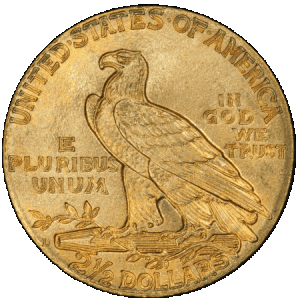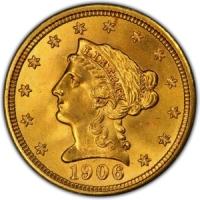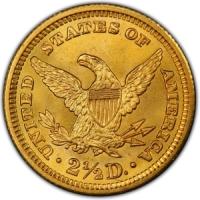Indian Quarter Eagles

 $2.50 Indian Gold Quarter Eagles - identical in design to the Indian Half Eagles
$2.50 Indian Gold Quarter Eagles - identical in design to the Indian Half Eagles
The $2.50 Indian Gold Quarter Eagles succeeded the $2.50 Liberty Gold Quarter Eagles in 1908. Whereas some other pre-1933 U.S. gold coins had been minted by up to 7 different branches of the US Mint, Indian Quarter Eagles were only minted in Philadelphia and Denver. More than 7 million Indian Gold Quarter Eagles were struck during the mintage period (1908 - 1915 & 1925 - 1929) so these are not rare gold coins. Only a very small number of proof coins were minted in Philadelphia though.
The Indian Head Quarter Eagles were made of 90% gold and 10% copper with each coin containing 0.12094 oz of gold. The obverse side of the coins shows a Native American Indian Chief wearing a traditional headdress. An eagle that is standing on a bundle of arrows and an olive branch can be seen on the reverse. That is the same design as on the $5 Indian Gold Half Eagles.
Collectors that prefer to buy gold coins that are a bit unusual should know that the Indian Head version of both the $5 Half Eagles and $2.50 Quarter Eagles share another special characteristic. Both coin types have their design incused below the surface and they also don't have a raised rim. American buyers that are investing in gold for their retirement should take note that the coins are not eligible for inclusion in Individual Retirement Accounts (IRA's) since they are classified as collectible gold coins by the IRS.


Coin Fact Sheet
| Weight | Face Value | Purity | Diameter |
|---|---|---|---|
| 0.12094 oz | US $ 2.50 | 90% | 18 mm |
Total Mintage: 7,250,261
Indian Quarter Eagle Coin Design
The design of the Indian Gold Quarter Eagle was created by Bela Lyon Pratt. It depicts an incredibly detailed image of a Native American Indian Chief wearing a traditional headdress on the obverse side. The designer's initials "B.L.P." and the year of mintage is inscribed underneath the portrait. Along the outer periphery appears the word "LIBERTY" as well as 13 stars that are meant to represent the original states of the United States.
The reverse side of the Indian Quarter Eagle coin depicts an eagle that is standing on a bundle of arrows and an olive branch. "IN GOD WE TRUST" is inscribed to the right of the eagle and "E PLURIBUS UNUM" appears to the left of the eagle's breast. The coin's denomination ("2 ½ DOLLARS") and "UNITED STATES OF AMERICA" is inscribed along the lower and upper edge of the coin. Each Indian Quarter Eagle that was minted in Denver contains the mint mark D next to the bundle of arrows. However, coins that were minted at the main Philadelphia branch of the United States Mint don't have any mint mark.
An unusual characteristic of the $2.50 Indian Gold Quarter Eagle is the fact that both sides have their design pressed into the coin surface. Furthermore, the coins don't have a raised rim like most other coins issued by the US Mint. This kind of recessed design was only used on one other coin minted by the US Mint, the $5 Indian Gold Half Eagle that is identical in design to the Indian Head Quarter Eagle.
History of the $2.50 Indian Gold Quarter Eagle
The Indian Head version of the $2.50 Quarter Eagle was commissioned by the American President Theodore Roosevelt in the early 1900's. The design was created by the artist Bela Lyon Pratt (a student of Augustus Saint-Gaudens) and production started in 1908 when the coins replaced the earlier Liberty Head Quarter Eagles. Regular continuous production of the coins ceased in 1915. Production resumed in 1925 and continued until 1929. The Indian Head $2.50 gold coins were popular as Christmas gifts during the 1910's and 1920's. The coins were rarely used in commerce though. With the economy starting to collapse at the onset of the Great Depression, the US Mint made the decision to stop production of these small coins. Circulation coins of the $2.50 denomination were never struck again henceforth by the US Mint.
Rare Dates
The coins minted in Denver in 1911 (55,680 coins) as well as in Philadelphia in 1914 (240,000 coins) are nowadays especially hard to find.
Proof coins are even harder to find if at all possible. Proof coins were exclusively minted in Philadelphia from 1908 to 1915 and annual proof mintages varied between 100 and 682 coins.
Mintage Numbers
Annual mintage of the Indian Quarter Eagle gold coin at the various US Mint branches varied between 55,680 coins (Denver 1911) and 722,000 coins (Philadelphia 1913). Proof coins were exclusively minted at the Philadelphia branch of the US Mint and proof mintage varied between 100 coins (1915) and 682 coins (1910).


Liberty Gold Quarter Eagles
The $2.50 Liberty Gold Quarter Eagles were the predecessors of the $2.50 Indian Gold Quarter Eagles. The US Mint produced them from 1840 to 1907. The coins were struck at the US Mint facilities in Philadelphia, New Orleans, San Francisco, Charlotte and Dahlonega. Their composition is 90% gold and 10% copper with each coin containing 0.12094 oz of gold. Close to 12 million Liberty Quarter Eagles were minted. However, only a tiny amount were minted in proof condition at the Philadelphia facility. Lady Liberty is shown in profile on the obverse side of the coins and an eagle that is holding a shield can be seen on the reverse.
The Liberty Gold Quarter Eagle page gives more information about the coins and allows you to compare current prices.